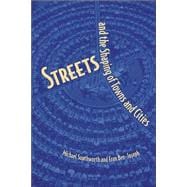
Note: Supplemental materials are not guaranteed with Rental or Used book purchases.
Purchase Benefits
What is included with this book?
| Acknowledgments | p. ix |
| Introduction: Street Standards and the Built Environment | p. 1 |
| The Power of Street Standards | p. 3 |
| The Social and Environmental Impacts of Street Standards | p. 5 |
| Trends in Street Design and Regulation | p. 7 |
| About This Book | p. 14 |
| Gritty Cities and Picturesque Villages: The Origins of Suburban Design Standards in England and the United States | p. 17 |
| A Brief Look at Street Design Standards of Antiquity | p. 17 |
| The First Suburbs in England | p. 28 |
| John Nash and Park Village | p. 29 |
| Olmsted, Vaux, and the American Suburb | p. 33 |
| Orderly Streets for Healthy Cities: Social Response to Urban Disorder | p. 43 |
| The "Bye-law" Street | p. 45 |
| Bedford Park Adapts the Bye-law Street | p. 47 |
| Unwin, Parker, and the Garden Cities | p. 50 |
| Charles Mulford Robinson and the Street as a Work of Art | p. 56 |
| Streets for the Motor Age: The Car and the Urban Scene | p. 61 |
| Movements for Road and Street Improvement | p. 61 |
| The Car in the Early 1900s | p. 64 |
| Early Responses to the Automobile | p. 65 |
| The Rise of Comprehensive Planning | p. 66 |
| Stein, Wright, and Radburn | p. 70 |
| Perry, Adams, and the Neighborhood Unit | p. 76 |
| European Modernism and the Vision for New Streets | p. 79 |
| The Asphalt Path | p. 83 |
| The Institute of Transportation Engineers Is Born | p. 83 |
| Bureaucracy Takes Control: The Institutionalization of Standards | p. 85 |
| The President's Conference on Home Building and Home Ownership | p. 85 |
| Adoption of Neighborhood Unit and Garden City Principles | p. 88 |
| Street Regulations Take Root | p. 89 |
| The Federal Housing Administration Promotes Suburbanization | p. 90 |
| FHA's First Standards | p. 91 |
| Standards Establish the Cul-de-sac Pattern | p. 92 |
| Controlling Subdivision through Local Plat Approval | p. 96 |
| The Influence of the Building Industry on Street Design | p. 97 |
| Accidents and Grids | p. 100 |
| Streets for Living: Rethinking Neighborhood Streets | p. 105 |
| Learning from Traditional Street Patterns | p. 105 |
| Kentlands | p. 106 |
| Laguna West | p. 108 |
| Elmwood: A Traditional Streetcar Suburb | p. 109 |
| Neotraditional Street Design and Pattern | p. 111 |
| Comparing Street Patterns | p. 113 |
| Pedestrian Access | p. 115 |
| The Shared Street Concept | p. 117 |
| Design Characteristics of Shared Streets | p. 122 |
| The Social Benefits | p. 124 |
| Safety | p. 125 |
| Prospects for Shared Streets in Suburbia | p. 126 |
| The Case for Cul-de-sacs | p. 128 |
| Walkable Suburbs? | p. 137 |
| Tomorrow's Streets: Toward New Neighborhood Street Standards | p. 139 |
| Liability Concerns in Reevaluating Standards | p. 140 |
| Local Controls and Design Initiatives | p. 141 |
| Semiprivate Streets for Flexibility | p. 144 |
| Performance Standards Versus Specifications | p. 146 |
| The Limitations of Flexible Planning | p. 149 |
| Some Design Criteria for Better Residential Street Standards | p. 150 |
| Looking at Community Street Standards | p. 154 |
| The Work Ahead | p. 155 |
| Chronology of Events in the Development of Residential Street Standards | p. 159 |
| A Graphic Survey of Street Cross Sections | p. 163 |
| Narrow Streets Data | p. 167 |
| Chapter End Notes | p. 171 |
| Other References | p. 183 |
| Index | p. 189 |
| Table of Contents provided by Ingram. All Rights Reserved. |
The New copy of this book will include any supplemental materials advertised. Please check the title of the book to determine if it should include any access cards, study guides, lab manuals, CDs, etc.
The Used, Rental and eBook copies of this book are not guaranteed to include any supplemental materials. Typically, only the book itself is included. This is true even if the title states it includes any access cards, study guides, lab manuals, CDs, etc.